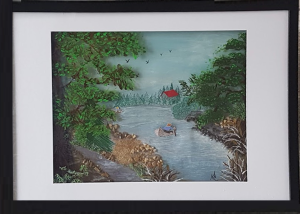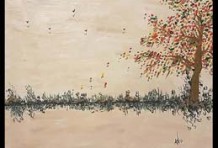 3D Art – Lighting Matters
3D Art – Lighting Matters
Make your 3D art pop! Adequate, strategically located lighting makes all the difference when displaying your newly acquired artwork. The angle of lighting changes the way the shadows are cast. As you view the 3D art from different angles the shadows shift.
Choosing the right lighting is as important as choosing the right location for your newly acquired 3D art. For maximum success, try moving your lighting if it doesn’t seem to be ideal.
Care for 3D Art
Care for your 3D art with the same care as you would any piece of fine art, and it will last for years. Do not use any cleaning products – homemade or commercial. Dust lightly and do not allow the piece to be in environments where it is exposed to grease splatter, or excessive heat or direct sunlight.
Most of my 3D art is framed, or framed and matted. Larger pieces may be sold unframed, allowing you to choose your own frame. Multiple surfaces on which I have painted and/or added various mediums to create the effect make it pop.
 Composition
Composition
The outer layer may or may not have paint and/or other mediums on it. This sometimes helps break up with the reflective aspects of the outer layer of glass or acrylic surface used in the framing process.
If there are mediums on the outer layer, the same cleaning techniques as would apply to an original acrylic or oil painting apply. Simply lightly dust the piece with a feather duster or similar. Do not use cleaning products or rub or clean like you clean windows, as this will ruin the 3D art piece.
The surfaces I use to create the 3D art effect include high definition acrylic or occasionally glass. Sometimes this creates reflections and glare. There isn’t a good alternative. Non-glare acrylic mutes and blurs things. This diminishes the advantage of producing a great piece of 3D art.
Others agree that anti-reflective acrylic sheets reduce the contrast between colors considerably. That reduces the meticulous hours of work to create dimension by using tones and hues to show depth or dimension. If excessive reflection is a problem, the answer is to hang your 3D art in a location with a little less reflective light or redirect the angle of the lighting.
Framers
If you do decide, now or at a later date to reframe your 3D art, here are a few things you may want to know.
While one framer, I talked to, suggested the answer is museum glass. I don’t think that is a feasible answer either. It is counterproductive to use a frame with museum glass, if the inner layers still have a reflective quality. As an artist, just as I enjoy the clarity of seeing Vancouver scenery first hand, I want my customers to see the art with the least blurriness.
The cost of museum glass can run $400-600 for a piece the size of one of my larger 3D art pieces. Seeing as I often use 2 or 3 layers that means a cost of over $1,200 – $1,800 in glass alone. Moreover the more sheets of glass used, the higher the risk becomes with regards to breakage.
Museum glass, often used in art galleries, transmits about 97-98% of light compared to non-reflective acrylic transmitting 88-89%. Museum glass is about 12 times more expensive than regular glass per sheet. I have talked to a number of Vancouver artists, and most do not use museum glass. Vancouver artists tend to use regular glass, despite the challenges with reflections because it produces better clarity.
Best Results:
High definition acrylic offers the best results. It provides for clearer crisper images. While there are two grades of acrylic that reduce glare, both have challenges when doing 3D art. The anti-glare is less effective and the expensive stuff is anti-reflection. The anti-glare is really ineffective for 3D art due to the fact that it mutes the tones and hues leaving for a much less dramatic 3D art piece.
It creates the reduced glare by blurring what you are seeing. I don’t think anyone invests in a piece of 3D art, setting out to see a blurred image. It reduces the glare by making the reflection fuzzy. However, that fuzziness does not end at the glare, it has to be all over the whole sheet meaning it is impacting the 3D art.
Reducing the image’s dynamic color range has a disappointing result when aiming for a good quality 3D art piece. Anti-glare acrylic reduces the glare by reflecting the light in different directions. The problem is it still reflects a lot of light.
Connect on Instagram

